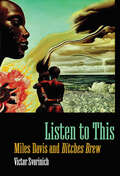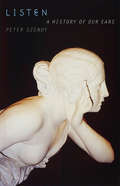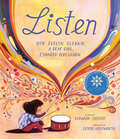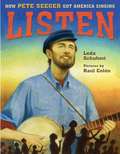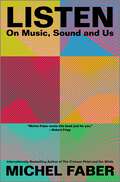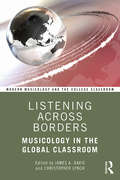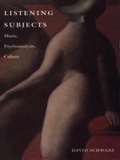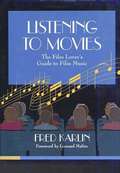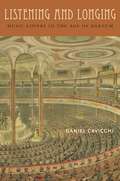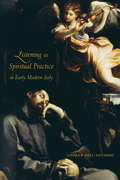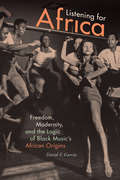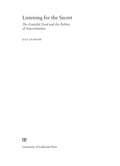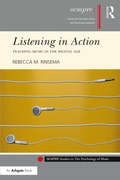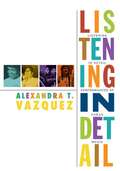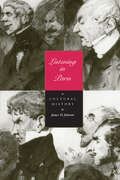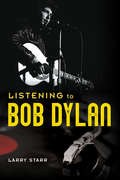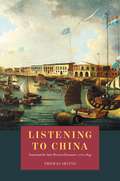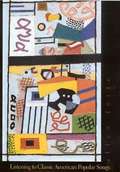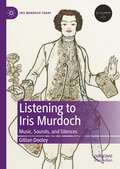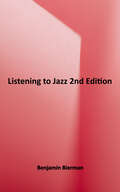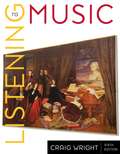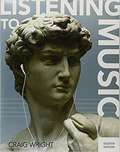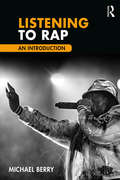- Table View
- List View
Listen to This: Miles Davis and Bitches Brew (American Made Music Series)
by Victor SvorinichListen to This stands out as the first book exclusively dedicated to Davis's watershed 1969 album, Bitches Brew. Victor Svorinich traces its incarnations and inspirations for ten-plus years before its release. The album arrived as the jazz scene waned beneath the rise of rock-and-roll and as Davis (1926–1991) faced large changes in social conditions affecting the African American consciousness. This new climate served as a catalyst for an experiment that many considered a major departure. Davis's new music projected rock-and-roll sensibilities, the experimental essence of 1960s' counterculture, yet also harsh dissonances of African American reality. Many listeners embraced it, while others misunderstood and rejected the concoction. Listen to This is not just the story of Bitches Brew. It reveals much of the legend of Miles Davis—his attitude and will, his grace under pressure, his bands, his relationship to the masses, his business and personal etiquette, and his response to extraordinary social conditions seemingly aligned to bring him down. Svorinich revisits the mystery and skepticism surrounding the album and places it into both a historical and musical context using new interviews, original analysis, recently found recordings, unearthed session data sheets, memoranda, letters, musical transcriptions, scores, and a wealth of other material. Additionally, Listen to This encompasses a thorough examination of producer Teo Macero's archives and Bitches Brew's original session reels in order to provide the only complete day-to-day account of the sessions.
Listen: A History of Our Ears
by Charlotte Mandell Jean-Luc Nancy Peter SzendyIn this intimate meditation on listening, Peter Szendy examines what the role of the listener is, and has been, through the centuries. The role of the composer is clear, as is the role of the musician, but where exactly does the listener stand in relation to the music s/he listens to? What is the responsibility of the listener? Does a listener have any rights, as the author and composer have copyright? Szendy explains his love of musical arrangement (since arrangements allow him to listen to someone listening to music), and wonders whether it is possible in other ways to convey to others how we ourselves listen to music. How can we share our actual hearing with others? Along the way, he examines the evolution of copyright laws as applied to musical works and takes us into the courtroom to examine different debates on what we are and aren’t allowed to listen to, and to witness the fine line between musical borrowing and outright plagiarism. Finally, he examines the recent phenomenon of DJs and digital compilations, and wonders how technology has affected our habits of listening and has changed listening from a passive exercise to an active one, whereby one can jump from track to track or play only selected pieces.
Listen: How Evelyn Glennie, a Deaf Girl, Changed Percussion
by Shannon StockerA gorgeous and empowering picture book biography about Evelyn Glennie, a deaf woman, who became the first full-time solo percussionist in the world. <p><p>"No. You can't," people said. But Evelyn knew she could. She had found her own way to listen. From the moment Evelyn Glennie heard her first note, music held her heart. She played the piano by ear at age eight, and the clarinet by age ten. But soon, the nerves in her ears began to deteriorate, and Evelyn was told that, as a deaf girl, she could never be a musician. What sounds Evelyn couldn’t hear with her ears, though, she could feel resonate through her body as if she, herself, were a drum. And the music she created was extraordinary. Evelyn Glennie had learned how to listen in a new way. And soon, the world was listening too. <P><P><i>Advisory: Bookshare has learned that this book offers only partial accessibility. We have kept it in the collection because it is useful for some of our members. Benetech is actively working on projects to improve accessibility issues such as these.</i>
Listen: How Pete Seeger Got America Singing
by Leda SchubertListen.There was nobody like Pete Seeger.Wherever he went, he got people singing. With his head thrown backand his Adam’s apple bouncing,picking his long-necked banjoor strumming his twelve-string guitar,Pete sang old songs,new songs,new words to old songs,and songs he made up.In this gorgeously written and illustrated tribute to legendary musician and activist Pete Seeger, author Leda Schubert highlights major musical events in Mr. Seeger's life as well important moments of his fight against social injustice. From singing sold-out concerts to courageously standing against the McCarthy-era finger-pointing, Pete Seeger's life is celebrated in this bold book for young readers with gorgeous illustrations by Raúl Colón.A Neal Porter BookThis title has Common Core connections.
Listen: On Music, Sound and Us
by Michel Faber"I'm not here to change your mind about Dusty Springfield or Shostakovich or Tupac Shakur or synthpop. I'm here to change your mind about your mind." There are countless books on music with much analysis given to musicians, bands, eras and/or genres. But rarely does a book delve into what's going on inside us when we listen.Michel Faber explores two big questions: how do we listen to music and why do we listen to music? To answer these questions, he considers a range of factors, which includes age, illness, the notion of "cool," commerce, the dichotomy between "good" and "bad" taste and much more. From the award-winning author of The Crimson Petal and the White and Under the Skin, this idiosyncratic and philosophical book reflects Michel Faber's lifelong obsession with music of all kinds. Listen will change your relationship with the heard world.
Listening Across Borders: Musicology in the Global Classroom (Modern Musicology and the College Classroom)
by James A. DavisListening Across Borders: Musicology in the Global Classroom provides readers with the tools and techniques for integrating a global approach to music history—within the framework of the roots, challenges, and benefits of internationalization—into the modern music curriculum. Contributors from around the world offer strategies for empowering students to critique the economic, ideological, and political structures that propagate global challenges. Applicable in a variety of classroom settings, the internationalized teaching methods collected here suggest fruitful ways forward in a global age, in three parts: Creating Global Citizens Teaching with Case Studies of Intercultural Encounters Challenges and Opportunities In reevaluating the role of higher education in a cosmopolitan world, modern educators have come to question the limits of geographically defined canons, traditional curricular content, and other longstanding teaching approaches. Listening Across Borders places the music history classroom at the center of the conversation about internationalization in higher education, embracing pedagogies that develop the skillsets to become global citizens in a world where international cooperation is increasingly essential.
Listening Subjects: Music, Psychoanalysis, Culture
by David SchwarzIn Listening Subjects, David Schwarz uses psychoanalytic techniques to probe the visceral experiences of music listeners. Using classical, popular, and avant-garde music as texts, Schwarz addresses intriguing questions: why do bodies develop goose bumps when listening to music and why does music sound so good when heard "all around?" By concentrating on music as cultural artifact, Listening Subjects shows how the historical conditions under which music is created affect the listening experience.Schwarz applies the ideas of post-Lacanian psychoanalytic theorists Slavoj Zizek, Julia Kristeva, and Kaja Silverman to an analysis of diverse works. In a discussion of John Adams's opera Nixon in China, he presents music listening as a fantasy of being enclosed in a second skin of enveloping sound. He looks at the song cycles of Franz Schubert as an examination and expression of epistemological doubts at the advent of modernism, and traverses fantasy "space" in his exploration of the white noise at the end of the Beatles' "I Want You (She's So Heavy)." Schwarz also considers the psychosexual undercurrent in Peter Gabriel's "Intruder" and the textual and ideological structures of German Oi Musik. Concluding with a reading of two compositions by Diamanda Galás, he reveals how some performances can simultaneously produce terror and awe, abjection and rage, pleasure and displeasure. This multilayered study transcends other interventions in the field of musicology, particularly in its groundbreaking application of literary theory to popular and classical music.
Listening To Movies: The Film Lover's Guide To Film Music
by Fred KarlinThis text is a lay person's guide to the world of film music, from the silent era to the present day. Oscar-winning film composer Fred Karlin describes how music is written and recorded for the movies; who the composers are and how they work with film makers; and the music itself - what to listen for in a film score, and what makes one score better than another.
Listening and Longing: Music Lovers in the Age of Barnum (Music Culture)
by Daniel CavicchiListening and Longing explores the emergence of music listening in the United States, from its early stages in the antebellum era, when entrepreneurs first packaged and sold the experience of hearing musical performance, to the Gilded Age, when genteel critics began to successfully redefine the cultural value of listening to music. In a series of interconnected stories, American studies scholar Daniel Cavicchi focuses on the impact of industrialization, urbanization, and commercialization in shaping practices of music audiences in America. Grounding our contemporary culture of listening in its seminal historical moment--before the iPod, stereo system, or phonograph--Cavicchi offers a fresh understanding of the role of listening in the history of music.
Listening as Spiritual Practice in Early Modern Italy
by Andrew Dell’antonioThe early seventeenth century, when the first operas were written and technical advances with far-reaching consequences--such as tonal music--began to develop, is also notable for another shift: the displacement of aristocratic music-makers by a new professional class of performers. In this book, Andrew Dell'Antonio looks at a related phenomenon: the rise of a cultivated audience whose skill involved listening rather than playing or singing. Drawing from contemporaneous discourses and other commentaries on music, the visual arts, and Church doctrine, Dell'Antonio links the new ideas about cultivated listening with other intellectual trends of the period: humanistic learning, contemplative listening (or watching) as an active spiritual practice, and musical mysticism as an ideal promoted by the Church as part of the Catholic Reformation.
Listening for Africa: Freedom, Modernity, and the Logic of Black Music's African Origins
by David F. GarcíaIn Listening for Africa David F. Garcia explores how a diverse group of musicians, dancers, academics, and activists engaged with the idea of black music and dance’s African origins between the 1930s and 1950s. Garcia examines the work of figures ranging from Melville J. Herskovits, Katherine Dunham, and Asadata Dafora to Duke Ellington, Dámaso Pérez Prado, and others who believed that linking black music and dance with Africa and nature would help realize modernity’s promises of freedom in the face of fascism and racism in Europe and the Americas, colonialism in Africa, and the nuclear threat at the start of the Cold War. In analyzing their work, Garcia traces how such attempts to link black music and dance to Africa unintentionally reinforced the binary relationships between the West and Africa, white and black, the modern and the primitive, science and magic, and rural and urban. It was, Garcia demonstrates, modernity’s determinations of unraced, heteronormative, and productive bodies, and of scientific truth that helped defer the realization of individual and political freedom in the world.
Listening for America: Inside The Great American Songbook From Gershwin To Sondheim
by Rob Kapilow“Not since the late Leonard Bernstein has classical music had a combination salesman-teacher as irresistible as Kapilow.” —Kansas City Star Few people in recent memory have dedicated themselves as devotedly to the story of twentieth- century American music as Rob Kapilow, the composer, conductor, and host of the hit NPR music radio program, What Makes It Great? Now, in Listening for America, he turns his keen ear to the Great American Songbook, bringing many of our favorite classics to life through the songs and stories of eight of the twentieth century’s most treasured American composers—Kern, Porter, Gershwin, Arlen, Berlin, Rodgers, Bernstein, and Sondheim. Hardly confi ning himself to celebrating what makes these catchy melodies so unforgettable, Kapilow delves deeply into how issues of race, immigration, sexuality, and appropriation intertwine in masterpieces like Show Boat and West Side Story. A book not just about musical theater but about America itself, Listening for America is equally for the devotee, the singer, the music student, or for anyone intrigued by how popular music has shaped the larger culture, and promises to be the ideal gift book for years to come.
Listening for the Secret: The Grateful Dead and the Politics of Improvisation
by Ulf OlssonListening for the Secret is a critical assessment of the Grateful Dead and the distinct culture that grew out of the group’s music, politics, and performance. With roots in popular music traditions, improvisation, and the avant-garde, the Grateful Dead provides a unique lens through which we can better understand the meaning and creation of the counterculture community. Marshaling the critical and aesthetic theories of Adorno, Benjamin, Foucault and others, Ulf Olsson places the music group within discourses of the political, specifically the band’s capacity to create a unique social environment. Analyzing the Grateful Dead’s music as well as the forms of subjectivity and practices that the band generated, Olsson examines the wider significance and impact of its politics of improvisation. Ultimately, Listening for the Secret is about how the Grateful Dead Phenomenon was possible in the first place, what its social and aesthetic conditions of possibility were, and its results. This is the first book in a new series, Studies and Texts of the Grateful Dead Phenomenon.
Listening in Action: Teaching Music in the Digital Age (SEMPRE Studies in The Psychology of Music)
by Rebecca M RinsemaIn an age when students come to class with more varied music listening preferences and experiences than ever before, music educators can find themselves at a loss for how to connect with their students. Listening in Action provides the beginnings of a solution to this problem by characterizing students’ contemporary music listening experiences as they are mediated by digital technologies. Several components of contemporary music listening experiences are described, including: the relationship between music listening experiences and listener engagements with other activities; listener agency in creating playlists and listening experiences as a whole; and the development of adolescent identities as related to the agency afforded by music listening devices. The book provides an accessible introduction to scholarship on music listening across the disciplines of musicology, ethnomusicology, sociology of music, psychology of music, and music education. By reading Listening in Action, music educators can gain an understanding of recent theories of music listening in everyday life and how those theories might be applied to bridge the gap between music pedagogies and students who encounter music in a heavily mediated, postperformance world.
Listening in Detail: Performances of Cuban Music
by Vazquez Alexandra T.Listening in Detail is an original and impassioned take on the intellectual and sensory bounty of Cuban music as it circulates between the island, the United States, and other locations. It is also a powerful critique of efforts to define "Cuban music" for ethnographic examination or market consumption. Contending that the music is not a knowable entity but a spectrum of dynamic practices that elude definition, Alexandra T. Vazquez models a new way of writing about music and the meanings assigned to it. "Listening in detail" is a method invested in opening up, rather than pinning down, experiences of Cuban music. Critiques of imperialism, nationalism, race, and gender emerge in fragments and moments, and in gestures and sounds through Vazquez's engagement with Alfredo Rodríguez's album Cuba Linda (1996), the seventy-year career of the vocalist Graciela Pérez, the signature grunt of the "Mambo King" Dámaso Pérez Prado, Cuban music documentaries of the 1960s, and late-twentieth-century concert ephemera.
Listening in Paris: A Cultural History (Studies on the History of Society and Culture #21)
by James H. JohnsonBeginning with the simple question, "Why did audiences grow silent?" Listening in Paris gives a spectator's-eye view of opera and concert life from the Old Regime to the Romantic era, describing the transformation in musical experience from social event to profound aesthetic encounter. James H. Johnson recreates the experience of audiences during these rich decades with brio and wit. Woven into the narrative is an analysis of the political, musical, and aesthetic factors that produced more engaged listening. Johnson shows the gradual pacification of audiences from loud and unruly listeners to the attentive public we know today.Drawing from a wide range of sources—novels, memoirs, police files, personal correspondence, newspaper reviews, architectural plans, and the like—Johnson brings the performances to life: the hubbub of eighteenth-century opera, the exuberance of Revolutionary audiences, Napoleon's musical authoritarianism, the bourgeoisie's polite consideration. He singles out the music of Gluck, Haydn, Rossini, and Beethoven as especially important in forging new ways of hearing. This book's theoretical edge will appeal to cultural and intellectual historians in many fields and periods.
Listening to Bob Dylan (Music in American Life)
by Larry StarrVenerated for his lyrics, Bob Dylan in fact is a songwriting musician with a unique mastery of merging his words with music and performance. Larry Starr cuts through pretention and myth to provide a refreshingly holistic appreciation of Dylan's music. Ranging from celebrated classics to less familiar compositions, Starr invites readers to reinvigorate their listening experiences by sharing his own—sometimes approaching a song from a fresh perspective, sometimes reeling in surprise at discoveries found in well-known favorites. Starr breaks down often-overlooked aspects of the works, from Dylan's many vocal styles to his evocative harmonica playing to his choices as a composer. The result is a guide that allows listeners to follow their own passionate love of music into hearing these songs—and personal favorites—in new ways. Reader-friendly and revealing, Listening to Bob Dylan encourages hardcore fans and Dylan-curious seekers alike to rediscover the music legend.
Listening to China: Sound and the Sino-Western Encounter, 1770-1839 (New Material Histories of Music)
by Thomas IrvineFrom bell ringing to fireworks, gongs to cannon salutes, a dazzling variety of sounds and soundscapes marked the China encountered by the West around 1800. These sounds were gathered by diplomats, trade officials, missionaries, and other travelers and transmitted back to Europe, where they were reconstructed in the imaginations of writers, philosophers, and music historians such as Jean-Philippe Rameau, Johann Nikolaus Forkel, and Charles Burney. Thomas Irvine gathers these stories in Listening to China, exploring how the sonic encounter with China shaped perceptions of Europe’s own musical development. Through these stories, Irvine not only investigates how the Sino-Western encounter sounded, but also traces the West’s shifting response to China. As the trading relationships between China and the West broke down, travelers and music theorists abandoned the vision of shared musical approaches, focusing instead on China’s noisiness and sonic disorder and finding less to like in its music. At the same time, Irvine reconsiders the idea of a specifically Western music history, revealing that it was comparison with China, the great “other,” that helped this idea emerge. Ultimately, Irvine draws attention to the ways Western ears were implicated in the colonial and imperial project in China, as well as to China’s importance to the construction of musical knowledge during and after the European Enlightenment. Timely and original, Listening to China is a must-read for music scholars and historians of China alike.
Listening to China: Sound and the Sino-Western Encounter, 1770-1839 (New Material Histories of Music)
by Thomas IrvineFrom bell ringing to fireworks, gongs to cannon salutes, a dazzling variety of sounds and soundscapes marked the China encountered by the West around 1800. These sounds were gathered by diplomats, trade officials, missionaries, and other travelers and transmitted back to Europe, where they were reconstructed in the imaginations of writers, philosophers, and music historians such as Jean-Philippe Rameau, Johann Nikolaus Forkel, and Charles Burney. Thomas Irvine gathers these stories in Listening to China, exploring how the sonic encounter with China shaped perceptions of Europe’s own musical development. Through these stories, Irvine not only investigates how the Sino-Western encounter sounded, but also traces the West’s shifting response to China. As the trading relationships between China and the West broke down, travelers and music theorists abandoned the vision of shared musical approaches, focusing instead on China’s noisiness and sonic disorder and finding less to like in its music. At the same time, Irvine reconsiders the idea of a specifically Western music history, revealing that it was comparison with China, the great “other,” that helped this idea emerge. Ultimately, Irvine draws attention to the ways Western ears were implicated in the colonial and imperial project in China, as well as to China’s importance to the construction of musical knowledge during and after the European Enlightenment. Timely and original, Listening to China is a must-read for music scholars and historians of China alike.
Listening to Classic American Popular Songs
by Gary Chapman Allen Forte Richard LalliIn the twenties, thirties, & forties, now-legendary American songwriters & lyricists, including George Gershwin, Richard Rodgers, Cole Porter, & many others, created a repertoire of popular songs, songs that have captured the hearts of generations of music lovers. In this book Allen Forte shares his love of American popular song. Readers can follow the music while listening to the accompanying compact disc, which was especially recorded for this volume by baritone Richard Lalli & pianist-arranger Gary Chapman, with Allen Forte, pianist-arranger for "Embraceable You" & "Come Rain or Come Shine. " Includes 52 musical examples.
Listening to Iris Murdoch: Music, Sounds, and Silences (Iris Murdoch Today Ser.)
by Gillian DooleyWhen we think of Iris Murdoch’s relationship with art forms, the visual arts come most readily to mind. However, music and other sounds are equally important. Soundscapes – music and other types of sound – contribute to the richly textured atmosphere and moral tenor of Murdoch’s novels. This book will help readers to appreciate anew the sensuous nature of Iris Murdoch’s prose, and to listen for all kinds of music, sounds and silences in her novels, opening up a new sub-field in Murdoch studies in line with the emerging field of Word and Music Studies. This study is supported by close readings of selected novels exemplifying the subtle variety of ways she deploys music, sounds and silence in her fiction. It also covers Murdoch’s knowledge of music and her allusions to music throughout her work, and includes a survey of musical settings of her words by various composers.
Listening to Jazz
by Benjamin BiermanThis book offers the most engaging introduction to the rich history and culture of jazz. Featuring coverage of all standard periods and genres--including a solid focus on contemporary jazz and ample coverage of Latin musicians and women in jazz--this text helps students understand how jazz evolved and how its various styles intersect and blend. Through in-depth listening guides and a narrative that addresses both social history and performance practice, students learn how to listen to and appreciate jazz in all its forms. For a truly rich learning experience, use the Listening to Jazz enhanced eBook. Access to the enhanced eBook is included with all new copies of the printed text and is also available for separate purchase.
Listening to Music
by Craig WrightDesigned for an introductory course in music appreciation, this lavishly illustrated textbook encourages students to become active listeners who engage personally with what they are hearing. Sound files for the listening exercises are contained on the two accompanying CDs. Wright teaches music at Yale U. Annotation ©2007 Book News, Inc. , Portland, OR (booknews. com)
Listening to Music
by Craig WrightCombining a student-friendly presentation with cutting-edge digital resources, LISTENING TO MUSIC equips you with the tools to actively listen to and inspire a lifelong appreciation for music. Known for his clear, conversational style, Professor Wright helps you immediately find connections to music by comparing pop and classical music concepts. His text is organized chronologically and discusses musical examples from each era in its social context -- describing the construction and culture of each piece.
Listening to Rap: An Introduction
by Michael Berry<p>Over the past four decades, rap and hip hop culture have taken a central place in popular music both in the United States and around the world. Listening to Rap: An Introduction enables students to understand the historical context, cultural impact, and unique musical characteristics of this essential genre. Each chapter explores a key topic in the study of rap music from the 1970s to today, covering themes such as race, gender, commercialization, politics, and authenticity. Synthesizing the approaches of scholars from a variety of disciplines—including music, cultural studies, African-American studies, gender studies, literary criticism, and philosophy—Listening to Rap tracks the evolution of rap and hip hop while illustrating its vast cultural significance. <p>The text features more than 60 detailed listening guides that analyze the musical elements of songs by a wide array of artists, from Afrika Bambaataa and Grandmaster Flash to Nicki Minaj, Jay-Z, Kanye West, and more. A companion website showcases playlists of the music discussed in each chapter. Rooted in the understanding that cultural context, music, and lyrics combine to shape rap’s meaning, the text assumes no prior knowledge. For students of all backgrounds, Listening to Rap offers a clear and accessible introduction to this vital and influential music.</p>
